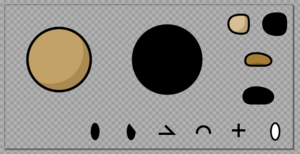Skin Creation/fr: Difference between revisions
(traduction du tuto anglais.) |
(Updating to match new version of source page) |
||
| Line 1: | Line 1: | ||
{{ | <languages/> | ||
{{Stub}} | |||
== | <div lang="en" dir="ltr" class="mw-content-ltr"> | ||
'''''Skin''''' files are 32-bit RGBA formatted in a 2:1 ratio. Each side of the image must be divisible by 4 pixels. | |||
</div> | |||
== | <div lang="en" dir="ltr" class="mw-content-ltr"> | ||
To create a skin, you'll need the appropriate software before you begin. It's advised to use a vector graphics image editor, as they produce clean exports and are easy to edit. Some popular choices are: | |||
</div> | |||
* [https://inkscape.org/ Inkscape] (free, open-source, | <div lang="en" dir="ltr" class="mw-content-ltr"> | ||
* [https://inkscape.org/ Inkscape] (free, open-source, and the choice of this tutorial) | |||
* [https://www.adobe.com/products/illustrator.html Adobe Illustrator] | * [https://www.adobe.com/products/illustrator.html Adobe Illustrator] | ||
* [https://affinity.serif.com/en-us/ Affinity Designer] | * [https://affinity.serif.com/en-us/ Affinity Designer] | ||
</div> | |||
<div lang="en" dir="ltr" class="mw-content-ltr"> | |||
Next, it's time to start making your skin. It's easiest to start from a pre-existing skin, or a template file. [https://github.com/ddnet/ddnet-data-svg/tree/main/skins This GitHub repo] contains many .svg remakes of popular skins. Let's take a look at the default skin .svg: | |||
</div> | |||
<div lang="en" dir="ltr" class="mw-content-ltr"> | |||
[[File:Default skin svg.png|thumb|default.svg]] | [[File:Default skin svg.png|thumb|default.svg]] | ||
</div> | |||
<div lang="en" dir="ltr" class="mw-content-ltr"> | |||
As we can see, each body part has a corresponding black shadow version. | |||
</div> | |||
<div lang="en" dir="ltr" class="mw-content-ltr"> | |||
The black shadow of each body part is the outline used in the tee as a whole. | |||
</div> | |||
<div lang="en" dir="ltr" class="mw-content-ltr"> | |||
Make sure these share the same shape as each body part, but with a larger stroke size. | |||
</div> | |||
[[Category:Tutorial{{#translation:}}]] | |||
Revision as of 20:29, 11 February 2023
Skin files are 32-bit RGBA formatted in a 2:1 ratio. Each side of the image must be divisible by 4 pixels.
To create a skin, you'll need the appropriate software before you begin. It's advised to use a vector graphics image editor, as they produce clean exports and are easy to edit. Some popular choices are:
- Inkscape (free, open-source, and the choice of this tutorial)
- Adobe Illustrator
- Affinity Designer
Next, it's time to start making your skin. It's easiest to start from a pre-existing skin, or a template file. This GitHub repo contains many .svg remakes of popular skins. Let's take a look at the default skin .svg:
As we can see, each body part has a corresponding black shadow version.
The black shadow of each body part is the outline used in the tee as a whole.
Make sure these share the same shape as each body part, but with a larger stroke size.

